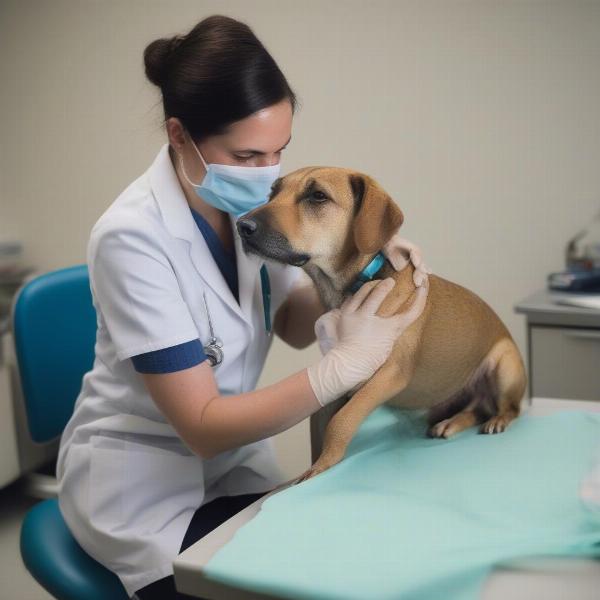Mupirocin is a topical antibiotic often used for human skin infections. But can you use mupirocin on dogs? The short answer is: sometimes, but only under the guidance of a veterinarian. It’s crucial to understand the specifics before applying any medication, even topical ones, to your furry friend. Using human medications on dogs can be risky and potentially harmful if not done correctly. Let’s delve deeper into the topic of mupirocin use in dogs.
Understanding Mupirocin and Its Uses in Dogs
Mupirocin works by stopping the growth of certain bacteria. In humans, it’s commonly used for conditions like impetigo and minor cuts or burns. While not FDA-approved for veterinary use, vets may prescribe mupirocin off-label for dogs to treat localized skin infections caused by susceptible bacteria. This means they’re using it for a purpose not specifically listed on the label, based on their professional judgement and experience.
When Might a Vet Prescribe Mupirocin for a Dog?
Your vet might consider mupirocin for superficial skin infections, such as:
- Hot spots (acute moist dermatitis): These are itchy, inflamed patches of skin that can develop quickly, often due to allergies or bacterial infections.
- Pyoderma: A bacterial skin infection that can manifest in various forms, including pustules, redness, and hair loss.
- Infected wounds: Mupirocin can help prevent or treat bacterial infections in minor cuts, scrapes, or surgical sites.
Risks and Precautions When Using Mupirocin on Dogs
While generally safe when used as directed by a vet, mupirocin can have potential side effects:
- Irritation: Some dogs may experience mild skin irritation, redness, or itching at the application site.
- Ingestion: Dogs may lick the ointment, and while not typically toxic in small amounts, large ingestion could lead to gastrointestinal upset. Prevent licking by using an Elizabethan collar (cone) if necessary.
- Allergic reactions: Although rare, allergic reactions are possible. Watch for signs like hives, swelling, or difficulty breathing.
Important Considerations Before Using Mupirocin
- Never use human mupirocin without veterinary guidance: The concentration and formulation may differ, and human medications can be dangerous for dogs.
- Always follow your vet’s instructions: Use the prescribed dosage and frequency.
- Monitor for side effects: If you notice any unusual reactions, contact your vet immediately.
Alternatives to Mupirocin for Dogs
Several other options exist for treating skin infections in dogs. Your vet can recommend the best course of action based on your dog’s specific condition:
- Other topical antibiotics: Different antibiotics may be more appropriate for certain types of infections.
- Oral antibiotics: For more severe or widespread infections, oral antibiotics might be necessary.
- Antiseptics and disinfectants: These can be helpful for cleaning wounds and preventing infection.
- dog anti bacterial cream
 Veterinarian examining a dog's skin infection
Veterinarian examining a dog's skin infection
Conclusion
While you can use mupirocin on dogs under specific circumstances, it’s vital to consult with your veterinarian first. They can determine if it’s the right treatment option for your dog’s condition, prescribe the appropriate dosage, and monitor for any potential side effects. Never self-medicate your dog, as this could have serious consequences. is mupirocin safe for dogs Only a veterinarian can assess the situation and provide the best care for your furry companion.
FAQ
- Is mupirocin the same for dogs and humans? No, while the active ingredient is the same, the formulations can differ. Always use a veterinary-prescribed product.
- Can I use expired mupirocin on my dog? No, never use expired medications. Their effectiveness diminishes, and they may even be harmful.
- What should I do if my dog licks mupirocin? Contact your vet immediately and inform them of the amount ingested.
- How long does it take for mupirocin to work on a dog? This depends on the infection and individual dog. You should start seeing improvement within a few days, but always complete the full course of treatment as directed by your vet.
- Can I use mupirocin on my dog’s ear? Only if specifically directed by your vet. Ear infections often require different medications.
- What are the signs of a skin infection in dogs? Redness, itching, hair loss, pustules, scabs, and a foul odor are common signs.
- Can I stop using mupirocin once the infection seems to be gone? No, always finish the prescribed course of medication even if the infection appears to have cleared. Stopping prematurely can lead to recurrence or antibiotic resistance.
ILM Dog is a leading online resource dedicated to providing expert advice on all aspects of dog care, from breed selection and health to training, nutrition, and grooming. We offer a wealth of information to help dog owners worldwide provide the best possible care for their beloved companions. Whether you’re a seasoned dog owner or just starting your journey, ILM Dog has the resources you need. mupirocin ointment for dogs For any questions or inquiries, please contact us at [email protected] or +44 20-3965-8624. is mupirocin for dogs the same as humans We are here to support you and your furry friend every step of the way.